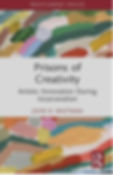The Creative Sentence: Art and Innovation Behind Bars
- Nancy Eiden
- Jul 22
- 4 min read
In his recently published book, Prisons of Creativity, Dr. John R. Whitman advances a bold thesis: incarcerated individuals are not just inmates—they are untapped creators whose artistic contributions can benefit society at large. Drawing on historical precedent, constitutional law, and programmatic case studies, Dr. Whitman challenges us to reimagine prisons not merely as detention centers, but as incubators of creative value.

Creativity During Incarceration: Why It Matters
Dr. Whitman begins by reframing creativity as a universal right—rooted in the U.S. Constitution’s Intellectual Property clause—which does not discriminate based on status or freedom. By denying prisoners access to arts education or IP protection, society forfeits streams of innovation and human potential. He argues that a nation’s competitive edge depends on harnessing creativity from all communities, especially those marginalized.
Beyond symbolic redemption, creativity offers transformative rehabilitation. Writing, music, visual arts and drama offer mental health benefits, structure, and a pathway to intellectual engagement. These activities foster resilience, agency, and purpose—especially vital in the isolating environment of incarceration.
Whitman highlights how scarcity and restriction—instead of crushing creative impulse—often force inventive problem‑solving. Prisoners repurpose everyday materials into art: Kool‑Aid dyes, reused forms for canvases, M&Ms as color pigments. Creative communities emerge informally—bunkmates teaching one another, creating collectives despite surveillance and constraint.
Barriers: Censorship & Lack of Rights
Despite this creativity, many incarcerated creators face censorship or administrative hostility. Works that critique institutional norms or explore radical themes may be suppressed. Some artists face consequences simply for expressing imaginative ideas that staff deem threatening.
Copyright poses another barrier: without knowledge or access to registration systems, incarcerated creators often lose control over their work. Whitman argues for creating mechanisms within prisons—library services, counseling, legal aid—to assist in IP protection and distribution.
Toward a National Framework: Carceral Creativity Policy
At the heart of the book is a proposed blueprint for a national Carceral Creativity Policy, modeled on federal legislation. Key elements include:
Widespread Arts‑in‑Corrections Programs—offering education and studio space for writing, art, and music.
Copyright Registration Assistance—empowering creators to protect and monetize their work.
Partnerships with Nonprofits—such as PEN America or American Prison Writing Archive, to distribute creative work beyond prison walls.
National Competitions—recognizing incarcerated creators and their contributions (e.g. expansion of the PEN Prison Writing Awards).
Financial Inclusion Structures—like a federal credit union to support banking and sales for justice-involved individuals.
Whitman underscores that any reform must be anchored in broader social justice goals—addressing mass incarceration, mental health, poverty, and sentencing reform—to make creativity accessible for all.
Real‑World Models & Case Studies
Dr. Whitman walks readers through existing arts-in-corrections examples, especially in California, which since the 1970s has pioneered in-prison creative education. He profiles superintendents and program leaders who facilitate musical ensembles, mural projects, haiku workshops, and more. These facilities show that artistic programs aren’t just beneficial—they are scalable and replicable nationwide.
Broader Impacts: Society & Social Economy
Creativity behind bars benefits more than the creator—it enriches families, communities, and the broader social economy. Visual art, writing, performances, and music created during incarceration can enter the public sphere, invigorating cultural dialogue, generating revenue, and challenging stereotypes. This widens intellectual diversity—and supports the Constitutional principle that creators’ rights belong to every citizen.
Prisons of Creativity reframes incarceration through the lens of innovation and possibility. It urges us to dismantle punitive exclusion and build systems where creation, expression, and justice co‑exist. For those engaged in criminal justice reform, arts education, or intellectual property advocacy, Whitman’s work offers both strategy and inspiration for unlocking humanity—and creativity—within the prison walls. It is both a manifesto and a roadmap—for educators, policymakers, criminal justice professionals, artists, and activists. The book delivers fresh arguments, backed up by legal analysis and human stories. Whitman doesn’t merely advocate—he challenges: how committed are we to unlocking the creative spirit behind bars?
A Call to Action
Whitman closes with a powerful call: to imagine prisons as engines of dignity and innovation rather than merely detention. He positions creativity as the bridge between punishment and renewal. Through legislation, institutional reform, and collaboration with civil society, incarcerated individuals can become contributors—honored for their artistic labor, not erased by their crimes.
Prisons of Creativity urges us to rethink incarceration—not as an endpoint, but as a transition point filled with human potential. With the right support, prisons can become spaces for education, artistic discovery, and innovation. By embedding creative programs into correctional curriculums, we not only affirm the humanity of incarcerated individuals but also strengthen public safety, reduce recidivism, and enrich society as a whole.
In partnership with Dr. Whitman, First Step Alliance is working on initiatives that integrate creative arts, entrepreneurship, and financial education into correctional facility curriculums.
By embedding these programs within the correctional environment, this collaboration aims to cultivate creativity, self-confidence, and future-oriented thinking during incarceration. Together, they aim to build a model that views personal growth as part of the daily fabric of prison education, not as an afterthought or privilege reserved for reentry.
About the author
John R. Whitman, Ph.D. Entrepreneur, academic, author: Whitman teaches and consults in business and nonprofit management with a specialty in social entrepreneurship and applying educational strategies to solve social problems. He has taught at American University, Babson College, Georgetown University, Harvard University Extension School, Northeastern University, and The University of Alabama in Huntsville. Co-founder of the Museum for Black Innovation and Entrepreneurship, he has also founded companies in software development (Oakland Group, Inc.), survey research (Surveytools Corporation), and film production (Camisary, Inc.). Publications include books and articles on the social economy, social entrepreneurship, philanthropy, intellectual property, cooperatives, creativity in prisons, and library management. Dr. Whitman received his A.B. from Boston University, Ed.M. from Harvard University, and Ph.D. from the University of Toronto (dissertation: Evaluating Philanthropic Foundations: A Comparative Social Values Approach, including foundations in Canada, Europe, and the United States). Dr. Whitman resides in Chicago.